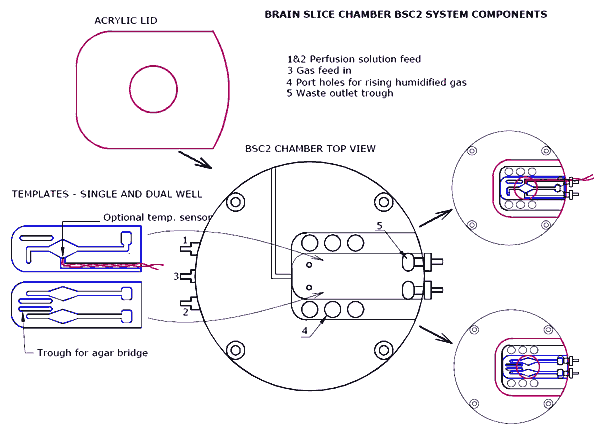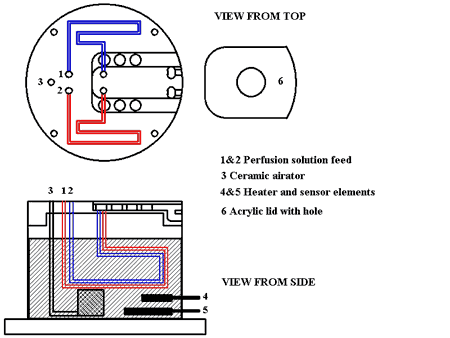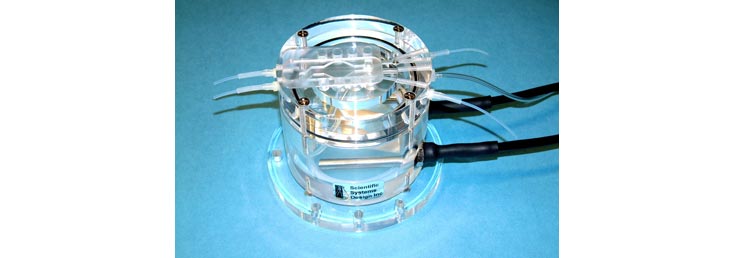BSC 2
The BSC2 chamber is designed to maintain isolated, living tissues in vitro in “interface” mode and allow stable electrophysiological recordings to be made from the preparation Murphy et al. (2000), Milner et al. (2002). The temperature is controlled by a proportional control heating unit, the PTC03.
Features
- "Interface" method of slice maintenance
- Dual feed channels for perfusion solution
- Use entire surface for multiple slices or templates
- Single and dual well templates, other designs available upon request
- Single well template has provision for temperature probe and ground wire
- Proportional temperature controller (PTCO3) with low noise performance used for heating methods of slice maintenance with same chamber
The chamber lower section is similar to the BSC1 for temperature control and oxygenation. Pre-oxygenated medium enters the main body of the chamber through two separate lines. These are fine bore PTFE tubes which spiral in the heated distilled water in the lower part of the chamber and enter the upper part of the chamber. Here any bubbles in the line break and allow perfusion fluid to flow smoothly towards the slices. Acrylic templates allow the option for use of a single well or two separate wells. (Other designs can be supplied upon request.) The templates are positioned on the chamber acrylic base and silicone grease used to make the seal on the bottom (see diagram below). Typical dead space volume for the single well is approx. 200 µl and each of the wells in the dual version is approx. 100 µl. The length of PTFE tubing carrying the perfusion solution to the wells has a volume of approx. 400 µl. The flow rate of the perfusion fluid is adjusted at the exit well by means of lens tissue which is used to wick solution out of the exit port. By adjusting the "over hang" the flow rate is effectively adjusted and determines the characteristics of the meniscus of fluid around the slice preparation. As with all interface preparations, the high oxygen tension is maintained by bubbling a 95 % oxygen, 5 % Carbon dioxide gas mixture through a ceramic bubbler located in the lower heated part of the chamber. This moistened and warmed gas mixture enters the upper part of the chamber via "port holes" and is then deflected by an acrylic cover across to the centrally located slice preparation. The temperature in the upper chamber is maintained by ensuring that the medium and moistened gas mixture enter at the required temperature. This is dependent on the temperature of the lower chamber body which is warmed by a heating element controlled by the Proportional Temperature Controller PTC03. An optional monitor sensor allows the upper chamber temperature to be checked when required.

BSC2 and template system

Notes: Single or dual channel templates are interchangeable. Dual channels have completely separate feed and exit ports.
Channels within the templates are diamond shaped for optimum flow and low dead space volume. Single red and blue lines opposite are PTFE tubes which spiral in the lower chamber before delivering the heated perfusate to the upper chamber. Ceramic aerator delivers fine bubbles of carbogen mixture into warmed distilled water in base of chamber. The warmed, humidified gas passes through port holes into the upper chamber and is then deflected and concentrated above the interface slice located in the template.
Proportional temperature controller PTC03 is used to maintain selected temperature via sensors and heating element located in lower chamber.





